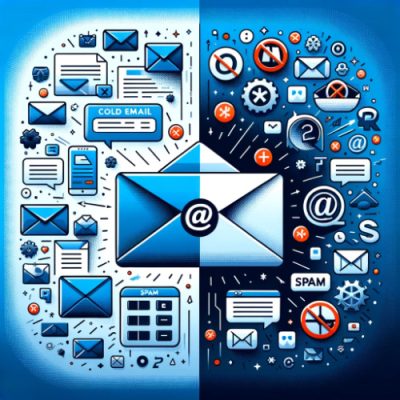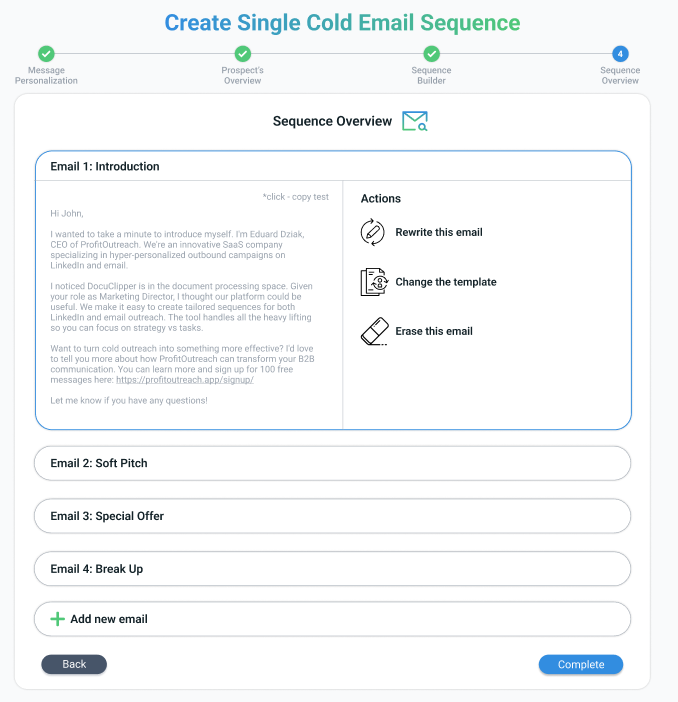Cold email marketing is still one of the best ways to grow your business, especially at the beginning of it.
However, there is a very fine line between cold email and spam email.
If you want your cold email to produce results and avoid becoming spam email, then you need to read our article on cold email vs spam email to ensure you don’t become one.
What is a Cold Email?
A cold email is an unsolicited email message sent to a prospective customer or client who has not directly consented to or requested information from the sender.
It is the first contact a business or salesperson makes to advertise products, services, events, or job opportunities, therefore, a cold email strategy is considered a TOFU (top of the funnel) strategy because prospects are often not in the market for the advertised product or service.
Cold emails aim to introduce a business and generate interest in hopes of developing new customer relationships.
They work to capture attention with compelling, personalized, and relevant offers crafted to align with the recipient’s presumed interests or needs.
Well-executed cold emails communicate value, avoid spam triggers, and make product suitability and further engagement clear so recipients opt-in for future messaging. Ultimately a cold email works to convert contact info into real business dialogues.
What is a Spam Email?
A spam email is an unsolicited bulk message sent indiscriminately to a list of recipients for commercial advertising or phishing purposes without consent.
It generally lacks personalized content, relevance, or value for the receiver. Spam emails often have misleading subject lines and false claims in attempts to get recipients to open, click links, provide personal information, or purchase something.
They violate privacy and facilitate scams or malware distribution. Due to ignoring opt-out preferences and utilizing purchased or scraped email lists, spam reliably reaches inboxes in mass volumes.
Spammers often send these emails from free or easy-to-recreate email addresses that are often very weird, but they like to present themselves as a legitimate company.
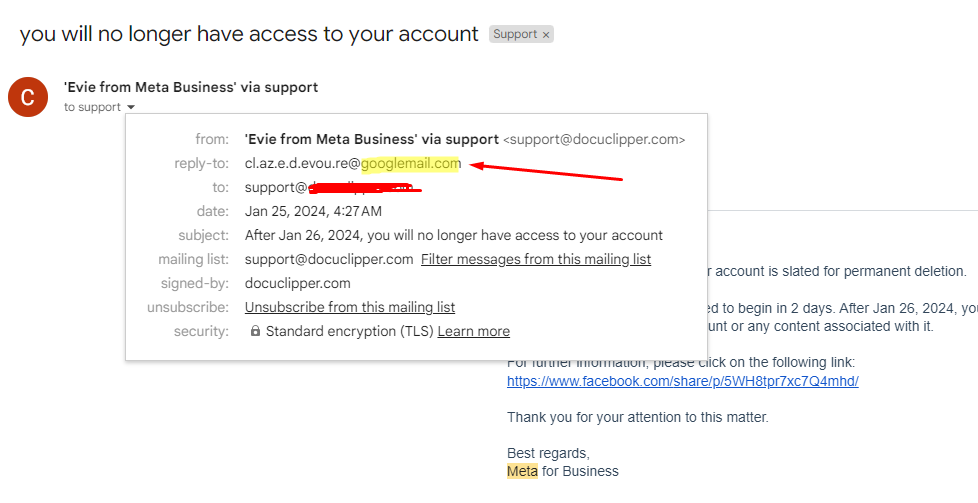
Anti-spam laws prohibit numerous spam email practices like failing to include physical mailing addresses or making deceptive or fraudulent commercial offers intended to exploit recipients.
The key factors qualifying emails as unlawful spam are lack of opt-in consent combined with bulk transmission of irrelevant content, dishonest messaging, and general non-compliance with consumer protection laws.
Spammers disregard anti-spam policies and pursue their abusive, invasive digital marketing without regard for recipients’ experience or privacy rights.
Key Differences Between Cold Email and Spam
However to better understand the differences between cold emails and spam emails, here I am going to provide you with the key differences that really differentiate cold emails from spam emails:
Intent and Target Audience
The core difference between cold email and spam starts with the sender’s fundamental intent and approach to targeting an audience.
Cold emails and spam have very different intents driving their communication and approaches to selecting an audience to target.
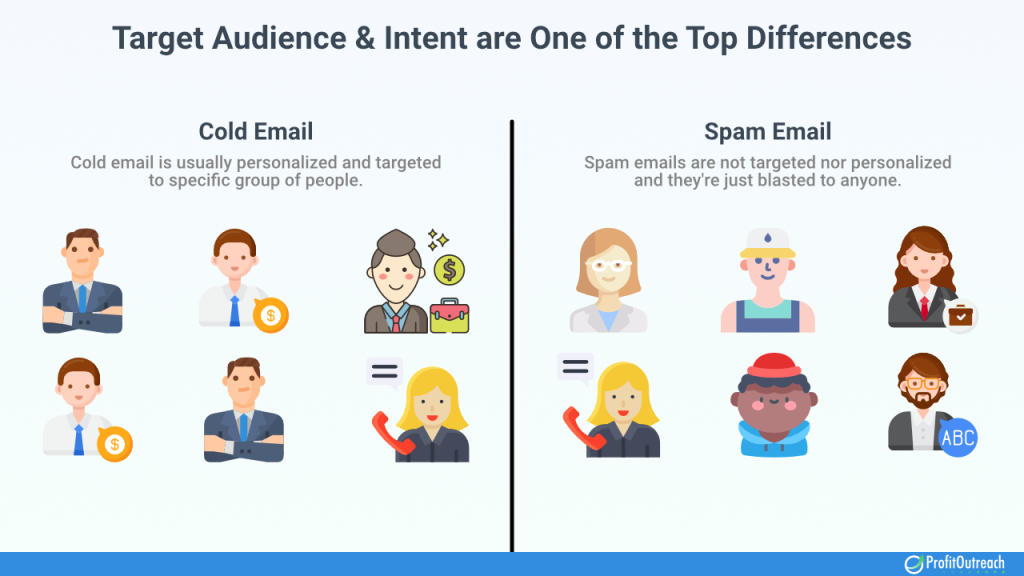
- Cold Email: Cold email senders take time to research and identify specific potential customers to contact with offers tailored and relevant to their interests or needs. The intent is to provide value and generate engagement from recipients who align with the product or service. The process involves more effort to create personalized emails but with higher potential returns.
- Spam Email: Spammers use email lists they purchased or scraped with no specific targeting or customization. Their only intent is efficiently broadcasting advertisements to as many email addresses as possible regardless of the suitability or interests of the recipients.
In summary, cold email is customized and aligned with prospective customer preferences while spam email randomly targets the widest possible audience with no consideration for relevance.
One provides value, the other aims only to benefit the sender.
Content and Personalization
The content and personalization approach is another big difference that sets cold emails apart from disruptive spam:
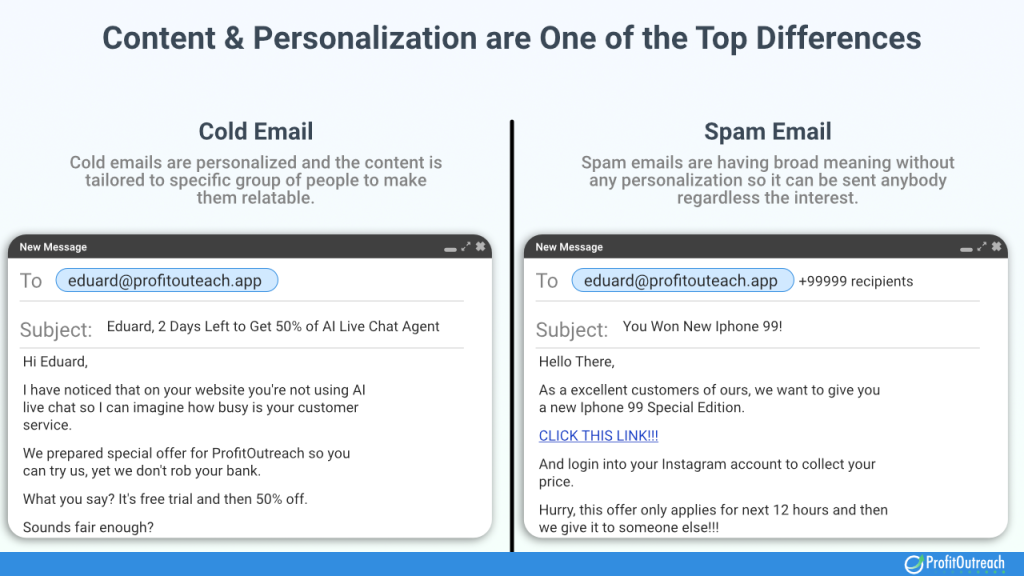
- Cold Email: Cold emails include customized copy and product or service descriptions relevant to the recipient’s industry, interests, or needs. The unique value propositions are tailored and credible. Personalized details demonstrating familiarity with the contact establish legitimacy while a friendly tone and lack of urgent calls-to-action promote engagement.
- Spam Email: Spam blasts generic promotional messages like advertisements, surveys, phishing, or political content without regard for the recipient’s preferences. Content is copied and pasted in bulk and the messages lack any specific personal details. False urgency and demanding calls to action pressure recipients.
In summary, cold email content offers genuine value via relevant information and offers customized to the recipient while spam email has generic, irrelevant messages with no personal details included.
Personalized copy and reputable content help cold emails avoid seeming like disruptive spam.
Compliance with Laws and Regulations
Another big difference between cold email and spam email is compliance with laws and regulations. Regulatory compliance is essential for legitimate email outreach efforts.
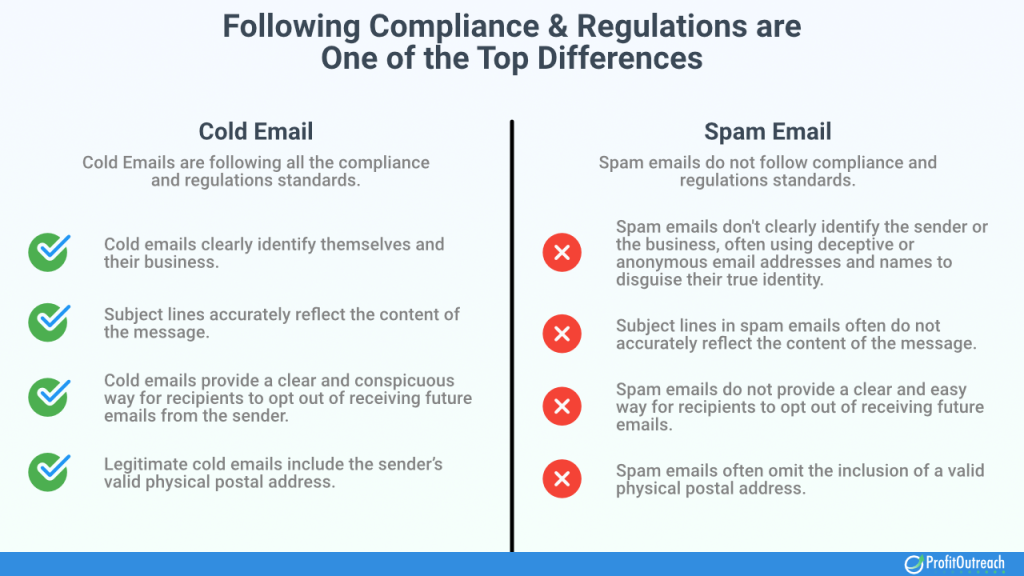
- Cold Email: Reputable cold email practices comply with laws like the CAN-SPAM Act or GDPR. This includes honoring opt-out requests, not disguising identities, and upholding transparency by providing mailing addresses and contact information. Complying with the fine print keeps quality marketers acting legally.
- Spam Email: Spam makes no effort to follow regulations. Violations like failing to properly identify the sender (often pretending to be from big trusted companies like Microsoft), lacking opt-out functionality, deploying malware, or selling counterfeit goods are widespread. Lack of consent or deceiving recipients into divulging data also breaks law.
In summary, though perceived as a nuisance by some, lawful cold email outreach respects standards protecting consumers from intrusive advertising.
Meanwhile, spammers operate illegally with blatant disregard for even basic anti-spam laws or consumers’ liberties. Staying compliant is a key ethical difference.
Frequency and Volume
The rate of messaging and overall email volume also varies drastically between cold outreach and spam blasts.
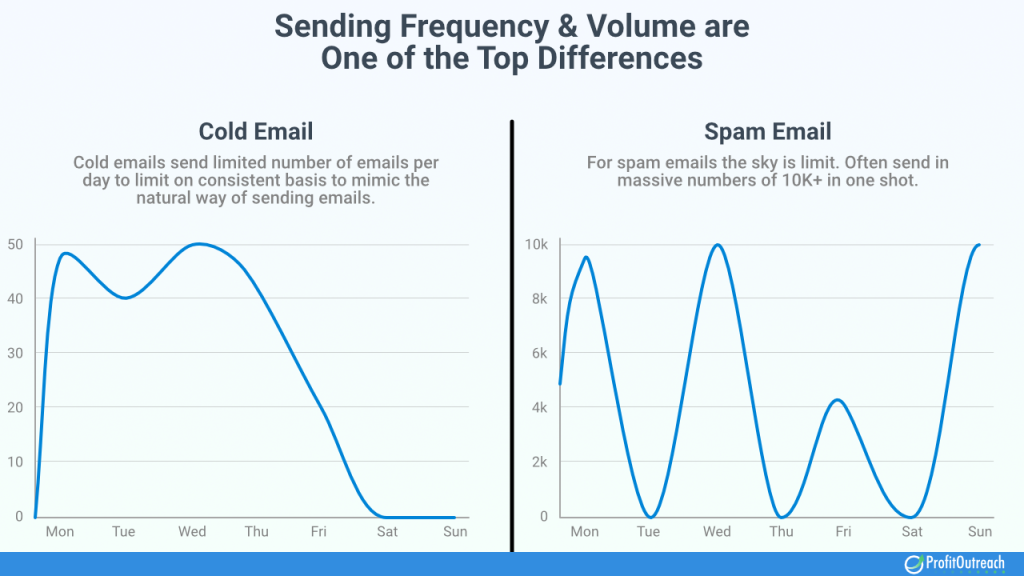
- Cold Email: Reputable cold email practices limit transmit frequency to avoid triggering spam filters and seem more natural. Sophisticated software helps limit hourly sends. Target lists focus on narrow, quality fits rather than entire databases. Personalized value-driven content warrants thoughtful engagement over mass blasting.
- Spam Email: Spammers blast immense volumes rapidly without limits. Using shoddy software or stolen data, they target countless addresses. Their simplistic untailored design enables infinitely scalable distribution constrained only by blacklist blocking, with millions of identical messages spammed globally through hijacked networks.
In summary, cold email maintains lower, strategically timed send rates restricted to well-researched recipients while spammers aggressively push content volume to unbounded limits uncaring about relevance in their nuisance messaging activities.
Carefully considered contact aligns with quality communication.
Content Quality
Another massive difference between cold and spam emails is the quality of the content and the effort the sender puts into the content:

- Cold Email: Cold email focuses on creating quality, value-driven content tailored specifically to each recipient. Relevance comes from research into ideal customer interests to craft persuasive propositions. Senders also work to build relationships through transparency, developing engaging dialogue beyond isolated campaigns rather than hard closing.
- Spam Email: Spam emails contain low-quality, distracting content like flashy advertising, surveys, or malicious links solely benefitting the sender, not the recipients. Messages get copied directly between broadly distributed batches showcasing no original value. Spammers lure or pressure users through deception without transparency about the source or intent.
In summary, cold email emphasizes quality material personalized for ideal recipients while spammers lazily duplicate shallow content broadly without customization only to exploit attention rather than earn it through valuable offerings. Prioritizing meaningful content underscores reliable communication.
Feedback and Engagement
Another big difference between cold email vs spam email is the care or lack of care for feedback and engagement statistics to deliver proper results:
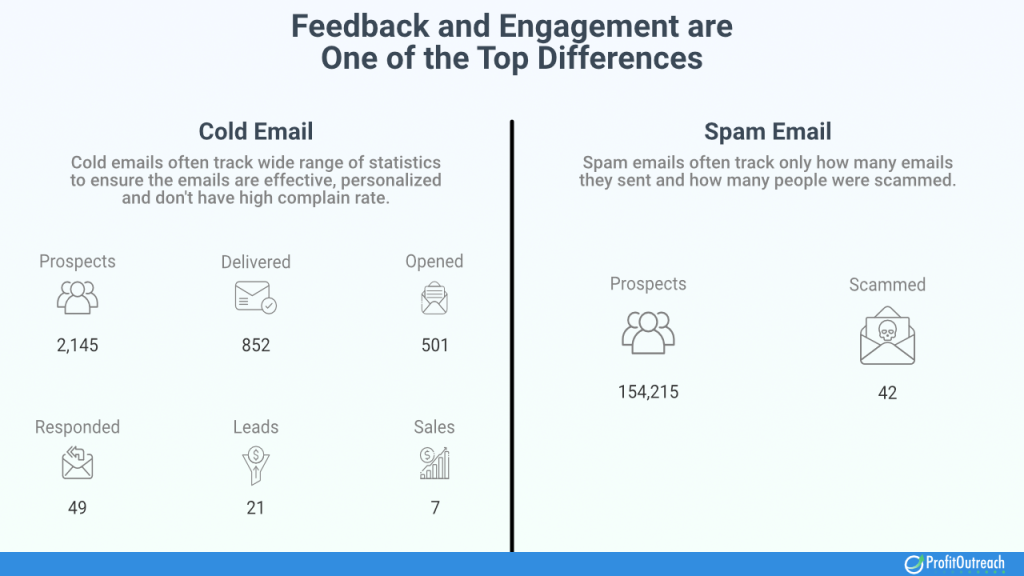
- Cold Email: Quality cold email marketers continually track cold email KPIs such as open, clickthrough, and complaint rates to test content and better reach the right audiences interested in their offerings. They personalize, deliver genuine value, restrict mailings to only qualified prospects, and adapt approaches over time to increase engagements or sales conversions. Refining the strategy and nurturing interest takes priority over bulk spamming.
- Spam Email: Spammers blast campaigns en masse without reviewing recipient behavior metrics or cold email follow-ups. They forge ahead contacting wider lists through deceptive content rather than revising unsuccessful techniques or developing lead relationships through value. Their model relies on scale over substance.
In summary, reputable cold email marketers foster engagements through testing and evolving effective outreach tailored for the right recipients while spammers continue exploiting contact data to transmit repetitive content without feedback adjustments or nurturing leads.
Remember, engagement quality overpasses quantity.
Sender Reputation
The last and arguably one of the most important signs of trusted cold email outreach from spam outreach is the sender’s reputation:
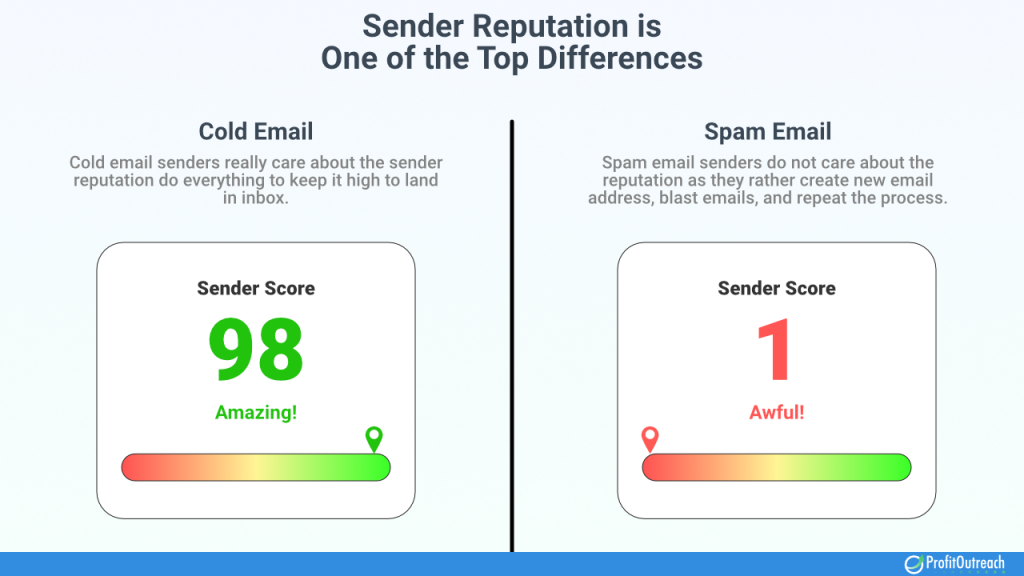
- Cold Email: Legitimate businesses send cold emails representing their real brand, contact info, and offerings to nurture public perception even if disruptive to some. They aim to build recognition aligned with their quality products or services rather than hide behind deception. Even mass marketers follow anti-spam laws and best practices considering long-term growth over short-term exploitation.
- Spam Email: Spammers frequently spoof legitimate brands in their email propaganda to mislead recipients by leveraging reputable names like Microsoft or Apple. Deception to earn clicks underscores the practice of disguising the true shady or malicious sender. When sources do get uncovered, any recognizable brands quickly denounce the violators while their reputation remains untouched by the spammer’s actions.
In summary, transparent cold email outreach intends to strengthen brand familiarity rooted in consumer trust while fraudulent spam hides behind falsified claims, disguises, and the reputations of large trusted organizations.
Remember a quality brand aligns with reliable communications. Learn more on how to find business emails for cold emailing.
Cold Email Best Practices
Executing an effective, legal, and spam-free cold email campaign requires following certain fundamental best practices that will help you get off to a good start
By focusing on cold email personalization, authentication, ethical content creation, tight targeting, and other critical factors, you can maximize cold email deliverability while minimizing complaints and maximizing the conversion rate.
Following the latest cold email trends while implementing these best practices will maximize your campaign’s effectiveness and keep your approach fresh and relevant.
Invest in Good Cold Email Outreach Software
The first best practice is to avoid building a cold outreach system from scratch using email-sending platforms such as Amazon SES and instead utilize specialized software platforms designed specifically for effective, compliant email campaigns.
Investing in trusted cold email software like Lemlist, Woodpecker, or Instantly can maximize deliverability through built-in optimization while also saving time otherwise spent manually researching and validating data.
The cold email software like these will help you to ensure that you follow all the technical cold email best practices and maximizing your deliverability rate.
Therefore, ensure that you invest in proper tools like these.
Personalized & Make Each Email Unique
Personalizing every single cold email is a vital best practice for increasing open and response rates while avoiding spam folder filters. (But also extremely time-consuming, so you should try ProfitOutreach)
Stock messages blasted to a general audience get ignored while customized communication demonstrates taking time to understand individual recipients’ needs.
Even minor details like including the prospect’s name, company, industry, location, or challenges make a difference.
Anything and everything that you can do to make every email that you send unique.
For example,
“As a California-based construction firm, you likely face current lumber price issues. Our new procurement analytics platform can help”
outperforms and outlasts generic blast messaging. Segmentation, research, mail merge tags, and manually customizing enough to treat recipients uniquely can make or break campaign success.
- Generic: We have procurement solutions to help your business. Learn more here!
- Personalized: As a {California}-based construction firm, you likely face current lumber price issues. Our new procurement analytics platform can help.
Utilizing spintax techniques can help create unique variations of your message while maintaining the core content, making each email appear individually crafted.
Create Tight Targeting
Another super important cold email best practice that you should follow is to create tight targeting.
It’s vital for you to precisely define and target only the most viable prospects instead of spraying across a wide generalized list.
Overtargeting wastes your resources and you would be reaching irrelevant inboxes while not meeting your goals.
Ideal cold email targeting first selects a specific segment, say West Coast retail chains, then identifies key decision-maker roles within, for example, Store Operations Managers and Inventory Planners, and targets company challenges like supply chain disruptions.
This bullseye focusing on industry, titles, use cases, and pain points filters prospects most qualified to buy your offering or forward it to the specialized internal teams with the highest interest.
Such strategic list building converts contacts into the best-qualified leads and delivers the best results.
Set Up Email Authentication
Email authentication protocols like Sender Policy Framework (SPF), DomainKeys Identified Mail (DKIM), and Domain-based Message Authentication, Reporting and Conformance (DMARC) should be implemented to maximize your deliverability and avoid spam filters.
These features verify the sending domain, encrypt the transmission, and authenticate the email sender by preventing spoofing and confirming the message’s origin.
Configuring the technical protocols ensures ISPs (Internet service providers, specifically email providers in this case.) that the cold outreach emails are legitimate, protected correspondence from validated sources.
This evidence of integrity allows bypassing spam detectors while also boosting your trust and response rates from an authenticated domain.
Overall, proper email authentication signals your outreach is reputable so ensure you always set it up.
Warm Up Your Domain Address
Before launching your cold email campaigns, you should gradually warm up domain and IP reputations to avoid temporary blocking from spam filters.
Warm-up software such as Lemwarm warms up new domain addresses by automatically sending initial emails at low volumes around 10-50 to verified inboxes.
Basically, these types of software will email each other and reply to each other to boost the reputation of the domain.
Warmups allow deliverability at scale by safely building sender credibility. Pre-emptively conditioning inboxes to recognize rather than automatically flag new mass emailers is critical for optimal queueing and inbox placement vital to campaign success.
Additionally, you want to ensure that the domain is older than 3 months + or 6 months+ old ideally to avoid spam detection as any new domains are not trusted.
Don’t Use Your Main Domain Address but Similar
When launching cold email campaigns another best practice is to avoid using your company’s primary public domain which has existing branding and reputation at stake if blacklisted.
You don’t want to screw this one.
Instead recently created separate domain names with strong similarities to the public name should be used.
For example for profitoutreach.app it could be “profitoutreach.co” or “profitoutreach.email”. As you can see, these clearly indicate from where they’re coming from, but the TLD is different.
Plus these less exposed domains insulate your public assets even if you get flagged for aggressive outreach while still leveraging name familiarity during the recipient’s split-second inbox scan.
Win-Win. 😊
Apply Spam Checkers
Before you start deploying any cold email campaign, the finalized templates should first get vetted through spam analysis tools to catch issues proactively.
Using Cold Email Spam Checker to scan subject lines and content for trigger words to surface possible red flags that could get your emails to land in a spam folder.
Wanna learn how to write the best cold email subject lines? We’ve got you covered!
Proactively self-checking and then refining anything called out in spam check reports allows strengthening deliverability in advance by confirming you aren’t overlooking factors that recipients or ISPs could deem suspicious, unethical, or promotional to the point of blocking distribution.
Verify Email Addresses Before Sending
Another VERY essential cold email best practice is to verify email addresses before contacting them.
Bouncing emails can tank your domain sender reputation so cold outreach contact lists should first run through email verification to confirm validity and activity.
Verifying helps identify high-risk, invalid or inactive addresses which if can hurt overall campaign deliverability if recipients report failed delivery attempts as spam.
Running your contact lists through services like ZeroBounce or MailTester to check mailbox existence, configuration, helps you to focus on sending emails to quality inboxes that are most likely to engage with you!
Don’t let incorrect or stagnant emails undermine your deliverability.
Avoid HTML Bload
When crafting your cold emails, remember that simplicity is key. You want to avoid HTML bloat – the overuse of complex HTML elements like intricate layouts, excessive images, and heavy styling.
This is not just about aesthetics; it’s about efficiency and deliverability.
You see when your email is overloaded with HTML, it can trigger spam filters, meaning your message might never reach its intended audience.
So, keep your emails straightforward and professional. Use HTML sparingly and focus on plain text where possible.
This approach ensures your emails are lightweight and quick to load, particularly important for mobile users.
Remember, your goal is to connect with your audience, not overwhelm them with visual overload. Keep it clean, keep it simple, and your message will be heard.
Avoid Misleading Subject Lines & Content
In your cold email campaign, honesty is everything.
You must avoid misleading subject lines and content at all costs. This practice isn’t just about adhering to legal standards; it’s about building trust with your audience.
Use subject lines that accurately reflect the email’s content while spiking interest and curious.
Even thou misleading titles may increase cold email open rates temporarily, they damage your credibility and trust with potential clients in the long run.
Trust me, a first impression is a lasting impression…
To ensure that the body of your email delivers on the promises made in the subject line!
This transparency fosters a genuine connection, encouraging recipients to engage meaningfully with your message. Remember, trust is the foundation of any successful business relationship.
Spam Regulations to Stay Aware of
To be successful at cold email outreach understanding spam regulations is essential part.
And in this section we’re going to introduce the most important that you should know:
- CAN-SPAM: This U.S. law sets the rules for commercial email. It establishes requirements for commercial messages, gives recipients the right to stop emails, and spells out tough penalties for violations. Key aspects include not using false or misleading header information, providing an opt-out mechanism, and ensuring subject lines aren’t deceptive.
- GDPR: The General Data Protection Regulation is a comprehensive data protection law in the EU. It demands explicit consent for the use of personal data, including email addresses. This regulation emphasizes the importance of respecting user privacy and being transparent about your data collection and usage practices.
- CASL: Canada’s Anti-Spam Legislation is one of the strictest in the world. It requires you to obtain explicit consent before sending commercial emails and to provide clear identification and an unsubscribe option in your emails.
- Abuse.net: Not a regulation but a resource, Abuse.net maintains a database of contacts for reporting spam. Knowing about it helps in understanding how recipients can react to unsolicited emails and the importance of maintaining clean mailing practices.
- SORBS: The Spam and Open Relay Blocking System is a list of servers known for transmitting or being involved in spam. Being aware of SORBS helps you ensure your email servers are not blacklisted, which can severely impact your email deliverability.
- URIBL: The Uniform Resource Identifier Blacklist is a tool used to identify URLs that appear in unsolicited emails. Knowing about URIBL can guide you in avoiding links in your emails that might be flagged as spam.
- SURBL: Similar to URIBL, the Spam URI Real-time Blocklists identify websites that have appeared in unsolicited messages. Awareness of SURBL helps you in ensuring that your email content is not inadvertently linked to these blacklisted sites.
Of course, not all of these regulations might apply to you, but it’s better to familiarize yourself with them, especially if you’re planning global cold email outreach.
It helps you in crafting not just legally compliant but also ethically sound email campaigns.
Remember, respecting these regulations is not just about avoiding legal repercussions; it’s about valuing and protecting your recipients’ rights and your brand’s reputation.
Is Cold Email Outreach Legal?
Yes, cold email outreach is legal, but it comes with specific conditions and requirements that vary depending on the country and the regulations in place that we’ve discussed.
That’s why understanding and adhering to these legal frameworks is crucial to ensure that your cold email campaigns are compliant.
Laws like CAN-SPAM and GDPR aim to balance commercial interests with consumer rights through mandates like straightforward opt-out systems, no deception, and reasonable contact frequency.
Well-designed, personalized, and value-focused cold email aligns with these standards when senders respect recipient preferences.
Conclusion
In conclusion, cold email outreach, when executed correctly and ethically, stands as an excellent marketing strategy to grow your business, especially at the beginning when the budget is a big concern.
It’s a fine balance between being assertive and respectful, informative yet concise.
Remember the key lies in understanding and respecting the thin line that separates a well-crafted cold email from spam.
Also remember, that the goal is to build trust and foster genuine business relationships, not just to make a sale.
With careful strategy and adherence to best practices, cold emailing can be a legitimate and valuable method of outreach.
FAQs about Cold Email vs Spam
In this section, we’re going to answer commonly asked questions about cold email vs spam and related:
Can spam act as cold email?
Yes, the CAN-SPAM Act applies to cold emails in the United States. It allows sending unsolicited commercial emails if they comply with key requirements: no misleading information in headers or subject lines, clear identification as an advertisement, inclusion of a valid physical postal address, and provision of an easy opt-out method. Compliance with these rules makes cold emailing legal under CAN-SPAM.
Is cold emailing considered spam?
No, cold emailing is not inherently considered spam. Cold emails are unsolicited emails sent to potential clients or customers with whom you have no prior relationship. However, if crafted and sent responsibly, following legal guidelines like the CAN-SPAM Act, GDPR, or CASL, and focusing on personalized, relevant content, cold emails are a legitimate form of business communication and not classified as spam.
How can I ensure my cold emails reach the inbox?
To ensure your cold emails reach the inbox, focus on personalized content, use a verified sender’s address, and maintain a clean mailing list. Additionally, comply with email authentication standards like SPF and DKIM. Avoid spam triggers in your subject line and content, and provide a clear opt-out option. Regularly monitor engagement metrics like open and click-through rates to adjust strategies for better deliverability.
Is junk email also cold email?
No, junk email and cold email are not the same. Junk email often refers to unwanted, unsolicited emails, typically spam, which are usually irrelevant and sent in bulk. Cold email, on the other hand, is a targeted, unsolicited email sent to potential clients or contacts, often personalized and relevant to the recipient’s interests or needs. Cold emails are legitimate business communications when done following legal guidelines and best practices.
What is considered a cold email?
A cold email is an unsolicited email sent to a potential client or contact with whom the sender has no prior relationship. It’s typically used for business development, networking, or sales purposes. Unlike spam, a cold email is personalized, relevant to the recipient’s interests or needs, and sent individually. When done ethically and in compliance with legal standards, cold emails are a legitimate form of business communication.
Why do cold emails go to spam?
Cold emails often go to spam due to triggers like generic content, frequent sending, use of sales-oriented language, or failure to comply with email authentication standards like SPF and DKIM. Lack of personalization, recipient relevance, and using a high-volume, non-verified email address also contribute. To avoid the spam folder, focus on personalized, relevant content, comply with legal standards, and maintain a healthy sender reputation.
Are spam and junk emails the same?
Yes, spam and junk emails are generally the same. Both terms refer to unsolicited, often irrelevant emails sent in bulk. These emails are typically filtered into a ‘spam’ or ‘junk’ folder by email services due to their nature, content, or sender’s reputation. They often include advertisements, promotional material, or potentially harmful links and are not personalized to the recipient.
Are cold emails legal in Europe?
Yes, cold emails are legal in Europe, but they must comply with the General Data Protection Regulation (GDPR). GDPR requires explicit consent for sending marketing emails to individuals, meaning you need permission from recipients before sending them cold emails. It’s crucial to have a lawful basis for processing personal data and to provide clear information about your identity and the purpose of your communication. Compliance with GDPR ensures that cold emailing is conducted legally and ethically in Europe.
Related Articles:
- Answer to How Many Cold Emails to Send Per Day
- Write the Best Cold Email Call To Action: Examples, Best Practices, and Tips
- Best Cold Email Opening Lines and How to Write Them
- How to Create a SaaS Cold Email Strategy
Cold Email Templates:
- Features Cold Email Template Guide: Examples, Best Practices, and Tips
- How to Write Introduction Cold Email Template
- Benefits Cold Email Template Guide: Examples, Best Practices, and Tips
